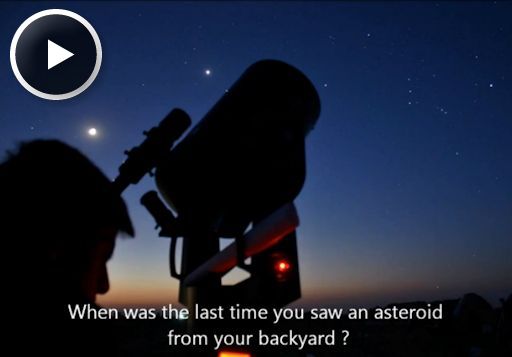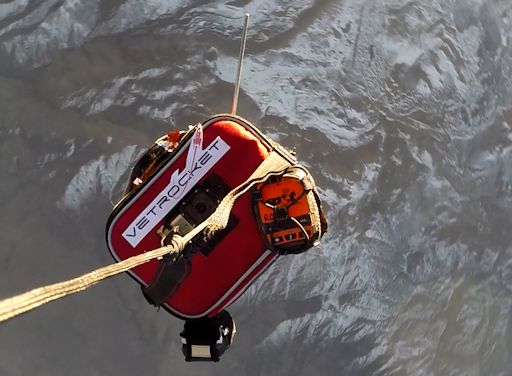Learn to photograph Northern Lights like a pro. Sign up for Peter Rosen's Aurora Photo Courses in Abisko National Park. | | |
UPTICK IN SOLAR ACTIVITY: After days of quiet, the sun is stirring. A new unnumbered sunspot emerging over the sun's southeastern limb is crackling with small explosions. Prompted by this development, NOAA forecasters have boosted the odds of an M-class solar flare today to 25%. Solar flare alerts: text, voice
SOLAR WIND SPARKS AURORAS: A stream of solar wind hit Earth during the late hours of Jan. 21st, igniting a bright display of auroras around the Arctic Circle. Oliver Wright sends this picture from Abisko, Lapland, Sweden:

"I spent some time on the lake this week and found a really cool cave where I could get behind the icicles," says Wright. "Tonight while having tea, I noticed the aurora. So a friend and I headed to the ice cave. I took a reindeer skin with me as it has been around the -30 C mark and crawled into the cave. I was intending to photograph in the other direction, but as I turned round I saw the opportunity for a shot. I asked my friend to stay very still and this is the result. I really like the refractions of the aurora and the photographer in the icicles."
More auroras are in the offing on Jan. 22nd as Earth continues through the solar wind stream. NOAA forecasters estimate a 45% chance of polar geomagnetic storms. Aurora alerts: text, voice
Realtime Aurora Photo Gallery
BRIGHT ASTEROID FLYBY: A large asteroid is about to fly past Earth. On the night of Jan. 26-27, mountain-sized space rock 2004 BL86 will be only 3 times farther from us than the Moon. There's no danger of a collision, but the flyby will be easy to observe. Sunlight reflected from the surface of 2004 BL86 will make it glow like a 9th magnitude star. Amateur astronomers with even small backyard telescopes will be able to see it zipping among the stars of the constellation Cancer. Check out this video, prepared by the Sociedad de Astronomia del Caribe, for detailed observing tips:

NASA radars will be observing, too. As the asteroid passes by, astronomers will use the Deep Space Network antenna at Goldstone, California, and the giant Arecibo radar in Puerto Rico to "ping" 2004 BL86, pinpointing the asteroid's location and tracing its shape.
"When we get our radar data back the day after the flyby, we will have the first detailed images," said radar astronomer Lance Benner of JPL, the principal investigator for the Goldstone radar observations of the asteroid. "At present, we know almost nothing about this asteroid, so there are bound to be surprises."
At the moment, astronomers think the asteroid is about a third of a mile (0.5 kilometers) in diameter. The flyby of 2004 BL86 will be the closest by any known space rock this large until asteroid 1999 AN10 flies past Earth in 2027.
Realtime Space Weather Photo Gallery
BALLOONING INTO THE SUNSET: On Jan. 14th, Spaceweather.com and the students of Earth to Sky Calculus launched a Space Weather Balloon to monitor cosmic rays. Unlike most of their launches, which happen in broad daylight, this one occurred at the end of the day. During the ascent into the stratosphere, the golden rays of the setting sun played across the fabric of the expanding balloon, painting it with all the colors of the sunset before the balloon was finally swallowed by darkness:

This was the 68th launch in the group's space weather ballooning program. The purpose of this particular flight was to measure high-altitude cosmic rays, which have been growing stronger since late Dec. 2014. Cosmic rays are energetic particles accelerated in our direction by active galactic nuclei, distant supernovas, and other sources across the Milky Way. Because these particles pepper Earth from all directions, it does not matter what time of day the Space Weather Balloons take off. Clearly, though, sunset launches have a special beauty.
The balloon's payload, which carried two radiation sensors to the stratosphere, traveled more than 94,000 feet high before the balloon popped (in darkness) and parachuted back to Earth, landing in Death Valley National Park. A recovery team had to hike more than 18 miles to retrieve the payload. A first look at the sensors suggests that excellent radiation data were collected during the flight. Later this week, the team hopes to present a summary of recent measurements, so stay tuned.
Hey thanks! This flight was sponsored by the folks at VetRocket, developers of high quality digital radiography products for veterinary applications. Here is their logo en route to the stratosphere:

VetRocket's generous donation of $500 made it possible to buy the helium and other supplies necessary to get our Space Weather Balloon off the ground.
Readers, if you would like to sponsor a flight and support the students involved in this research, please contact Dr. Tony Phillips for details.
Realtime Comet Photo Gallery
Every night, a network of NASA all-sky cameras scans the skies above the United States for meteoritic fireballs. Automated software maintained by NASA's Meteoroid Environment Office calculates their orbits, velocity, penetration depth in Earth's atmosphere and many other characteristics. Daily results are presented here on Spaceweather.com.
On Jan. 22, 2015, the network reported 8 fireballs.
(8 sporadics)

In this diagram of the inner solar system, all of the fireball orbits intersect at a single point--Earth. The orbits are color-coded by velocity, from slow (red) to fast (blue). [Larger image] [movies]
Potentially Hazardous Asteroids (
PHAs) are space rocks larger than approximately 100m that can come closer to Earth than 0.05 AU. None of the known PHAs is on a collision course with our planet, although astronomers are finding
new ones all the time.
On January 22, 2015 there were 1537 potentially hazardous asteroids.
Notes: LD means "Lunar Distance." 1 LD = 384,401 km, the distance between Earth and the Moon. 1 LD also equals 0.00256 AU. MAG is the visual magnitude of the asteroid on the date of closest approach. | | The official U.S. government space weather bureau |
| | The first place to look for information about sundogs, pillars, rainbows and related phenomena. |
| | Researchers call it a "Hubble for the sun." SDO is the most advanced solar observatory ever. |
| | 3D views of the sun from NASA's Solar and Terrestrial Relations Observatory |
| | Realtime and archival images of the Sun from SOHO. |
| | from the NOAA Space Environment Center |
| | the underlying science of space weather |

